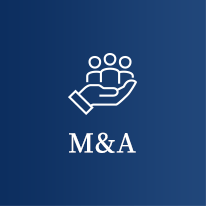Inheritance tax valuation of shares with no trading market price with respect to family shares
Inheritance tax valuation of shares with no trading market held by family shareholders
In the inheritance tax valuation of non-traded shares, the shares held by family shareholders are subject to both the comparable industry method and the net asset value method at a certain ratio depending on the size of the company, and the total of these two methods is used to calculate the share price. The ratio between the comparable industry method and the net asset value method is determined according to the size of the company.
Large size of the company Comparable industry value 100%.
Medium to large size of the company Comparable industry value x 0.9 + Net asset value x 0.1
Medium to medium size of the company Comparable industry value x 0.75 + Net asset value x 0.25
Small to medium size of the company Comparable industry value x 0.6 + Net asset value x 0.4
Small size of the company Comparable industry value x 0.5 + Net asset value x 0.5
The distinction between large size of the company, medium size of the company, and small size of the company is based on the standards set by the IRS, and different standards are used for wholesale, retail, and service businesses and for other businesses (e.g., manufacturing). For example, for companies that are not in the wholesale, retail, or service industry, the classification by size is as follows:
Large size of the company
Net assets of at least 1 billion and more than 50 employees, or transactions of at least 2 billion
Medium to large size of the company
Net assets of 700 million or more and more than 50 employees, or transactions of 1.4 billion or more but less than 2 billion
Medium to medium size of the company
Net assets of 400 million or more and more than 30 employees, or transaction value of 700 million or more and less than 1.4 billion
Small to medium size of the company
Net assets of 50 million or more and more than 5 employees, or transaction amount of 80 million or more but less than 700 million
Small size of the company
Net assets less than 50 million or employees less than 5 or transactions less than 80 million
Of the above, net assets and number of employees are “and”, so both conditions must be met. For example, a company with net assets of 800 million yen and 80 employees would not meet the “more than 1 billion yen and more than 50 employees” requirement, and would not meet the requirements for a large company with respect to this requirement. Similarly, a company with net assets of 500 million yen and 20 employees would have net assets of 400 million yen or more but fewer than 30 employees, so it would not meet the requirement of “net assets of 400 million yen or more and more than 30 employees.
Of the above requirements, the “net asset/employee criterion” and the “transaction amount criterion” are linked by “or”, which means that either of the conditions must be met. For example, a company with net assets of 800 million yen and 40 employees does not meet the “net assets of 1 billion yen or more and more than 50 employees” requirement, but if it has 2.1 billion yen in transactions, it meets the “transaction amount of 2 billion yen or more” requirement and thus falls under the “large company” category.
When using the net asset value method, it is necessary to deduct the amount calculated by subtracting the total amount of liabilities from the total assets based on the inheritance tax assessed value, and then multiplying the amount by the applicable tax rate for the tax portion imposed on the unrealized gains.
The net asset value is calculated from the company’s balance sheet. However, when determining the inheritance tax valuation, an adjustment must be made to the assets using the inheritance tax assessed value, such as by calculating unrealized gains. For example, even if the value of the property on the books is 100 million yen based on the acquisition price, if the assessed value for inheritance tax purposes is 150 million yen (which is about 0.7 times of the market value because it is calculated using land assessment value, etc.), the total assets based on the inheritance tax assessed value will be calculated by reflecting 50 million yen of unrealized gains.
For example, if the book value of total assets is 1 billion yen, adjusted by inheritance tax assessed value (unrealized gain) is 100 million yen, and liabilities are 700 million yen, net asset value is calculated by adding 100 million yen to 1 billion yen and then deducting 700 million yen in liabilities (1 billion yen + 100 million yen – 700 million yen = 400 million yen). However, if this calculation is left unchanged, there is a lack of consideration of future taxes on unrealized gains. Therefore, when determining the net asset value, it is necessary to deduct the amount of taxes that will be imposed in the future. If the applicable tax rate is 38%, the amount equivalent to 38% of the valuation difference must be deducted. The formula for calculating the share price using the net asset value method after taking these factors into account is as follows.
(Total asset value based on inheritance tax assessment – Total liabilities – 38% of the valuation difference) / Total number of shares issued and outstanding
*Of the above, valuation difference = net asset value based on inheritance tax assessment – book value net asset value
In the above example, valuation difference = 1.1 billion yen – 1 billion yen = 100 million yen
(1.1 billion yen – 700 million yen – 38 million yen) / 10,000 shares (total number of shares outstanding) = 36,200 yen
In the calculation of the share price using the comparable industry method, which is applicable to small and medium-sized enterprises, both the comparable industry value and the value based on the net asset value method are added together in a certain ratio (weight), so the net asset value method is also required. Please note that the unrealized gains must be adjusted for inheritance tax, and the portion of taxes to be imposed in the future must be deducted from the total asset value.










